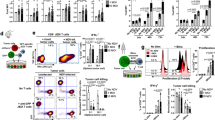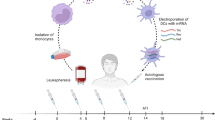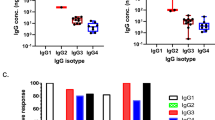Abstract
Recombinant expression vectors represent a powerful way to deliver whole antigens (Ags) for immunization. Sustained Ag expression in vector-infected dendritic cells (DC) combines Ag-specific stimulation with powerful costimulation and, simultaneously, through ‘self-selection’ of ad hoc epitopes broadens the scope of immunization beyond restrictions posed by individual patients' human leukocyte antigen (HLA) phenotype. In this study, therefore, we evaluated the efficiency of a recombinant vaccinia virus encoding the gp100/PMel17 melanoma Ag (rVV-gp100) to infect immature (iDC) or mature dendritic cells (mDC) derived from circulating mononuclear cells and the effect of infection on their status of maturation. In addition, we tested the ability of rVV-gp100-infected iDC and mDC to present the HLA-A*0201-associated gp100:209-217 epitope (g209). Irrespective of status of maturation, rVV-gp100 infection induced gp100 expression while only partially reversing the expression of some maturation markers. However, endogenous presentation of the wild-type g209 epitope was inefficient. The low efficiency was epitope-specific since infection of DC with rVV encoding a gp100 construct containing the modified gp100:209-217 (210M) (g209-2M) epitope characterized by high binding affinity for HLA-A*0201 restored efficient Ag presentation. Presentation of an HLA-class II-associated epitope and cytokine release by DC was not altered by rVV infection. Thus, Ag expression driven by rVV may be an efficient strategy for whole Ag delivery. However, since the effectiveness of Ag processing and presentation is subject to stringent HLA/epitope pairing, and for other yet undefined rules, the assumption that whole Ag delivery may circumvent HLA restriction is incorrect and recombinant expression vectors encoding well-characterized polyepitopic constructs may prove more effective.
This is a preview of subscription content, access via your institution
Access options
Subscribe to this journal
Receive 12 print issues and online access
$259.00 per year
only $21.58 per issue
Buy this article
- Purchase on Springer Link
- Instant access to full article PDF
Prices may be subject to local taxes which are calculated during checkout







Similar content being viewed by others
References
Bhardwaj N, Friedman SM, Cole BC, Nisanian AJ . Dendritic cells are potent antigen-presenting cells for microbial superantigens. J Exp Med 1992; 175: 267–273.
Bhardwaj N . Processing and presentation of antigen by dendritic cells: implications for vaccines. Trends Mol Med 2001; 7: 388–394.
Albert ML, Sauter B, Bhardwaj N . Dendritic cells acquire antigen from apoptotic cells and induce class I-restricted CTLs. Nature 1998; 392: 86–89.
Fontaneau JF, Larsson M, Bhardwaj N . Dendritic cell–dead-cell interactions: implications and relevance for immunotherapy. J Immunother 2001; 24: 294–304.
Bronte V et al. Antigen expression by dendritic cell correlates with the therapeutic effectiveness of a model recombinant poxvirus tumor vaccine. Proc Natl Acad Sci USA 1997; 94(7): 3183–3188.
Bhardwaj N et al. Influenza virus-infected dendritic cells stimulate strong proliferative and cytolytic responses from human CD8+ T cells. J Clin Invest 1994; 94: 797–807.
Kim CJ et al. Dendritic cells infected with poxviruses encoding MART-1/MelanA sensitize T lymphocytes in vitro. J Immunother 1997; 20: 276–286.
Kim CJ et al. Use of recombinant poxviruses to stimulate anti-melanoma T cell reactivity. Ann Surg Oncol 1998; 5: 64–76.
Schutz A et al. Immunogenicity of nonreplicating recombinant vaccinia expressing HLA-A201 targeted or complete MART-1/MelanA antigen. Cancer Gene Ther 2001; 8: 655–661.
Sette A et al. The relationship between class I binding affinity and immunogenicity of potential cytotoxic T cell epitopes. J Immunol 1994; 153: 5586–5592.
Kawakami Y et al. Identification of the immunodominant peptides of the MART-1 human melanoma antigen recognized by the majority of HLA-A2-restricted tumor infiltrating lymphocytes. J Exp Med 1994; 180: 347–352.
Kawakami Y et al. Recognition of multiple epitopes in the human melanoma antigen gp100 by tumor-infiltrating T lymphocytes associated with in vivo tumor regression. J Immunol 1995; 154: 3961–3968.
Parkhurst MR et al. Improved induction of melanoma reactive CTL with peptides from the melanoma antigen gp100 modified at HLA-A*0201 binding residues. J Immunol 1996; 157: 2539–2548.
Valmori D et al. Diversity of the fine specificity displayed by HLA-A*0201-restricted CTL specific for the immunodominant Melan-A/MART-1 antigenic peptide. J Immunol 1998; 161: 6956–6962.
Rivoltini L et al. A superagonist variant of peptide MART-1/Melan A27-35 elicits anti-melanoma CD8+ T cells with enhanced functional characteristics: implications for more effective immunotherapy. Cancer Res 1999; 59: 301–306.
Valmori D et al. Optimal activation of tumor-reactive T cells by selected antigenic peptide analogues. Int Immunol 1999; 11: 1971–1980.
Salgaller ML, Marincola FM, Cormier JN, Rosenberg SA . Immunization against epitopes in the human melanoma antigen gp100 following patient immunization with synthetic peptides. Cancer Res 1996; 56: 4749–4757.
Rosenberg SA et al. Immunologic and therapeutic evaluation of a synthetic tumor associated peptide vaccine for the treatment of patients with metastatic melanoma. Nat Med 1998; 4: 321–327.
Iezzi G, Karjalainen K, Lanzavecchia A . The duration of antigenic stimulation determines the fate of naive and effector T-cells. Immunity 1998; 8: 89–95.
Lanzavecchia A, Iezzi G, Viola A . From TCR engagement to T-cell activation: a kinetic view of T cell behavior. Cell 1999; 96: 1–4.
Larsson M et al. Requirement of mature dendritic cells for efficient activation of influenza A-specific memory CD8+ T cells. J Immunol 2000; 165: 1182–1190.
Steinman RM & Dhodapkar M . Active immunization against cancer with dendritic cells: the near future. Int J Cancer 2001; 94: 459–473.
Jonuleit H et al. A comparison of two types of dendritic cells as adjuvants for the induction of melanoma-specific T cell responses in humans following intranodal injection. Int J Cancer 2001; 93: 243–251.
Engelmayer J et al. Vaccinia virus inhibits the maturation of human dendritic cells: a novel mechanism of immune evasion. J Immunol 1999; 163: 6762–6768.
Smith GL et al. Vaccinia virus immune evasion. Immunol Rev 1997; 159: 137–154.
Tsujisaki M et al. Fine specificity and idiotype diversity of the murine anti-HLA- A2, A28 monoclonal antibodies CR11-351 and KS1. Transplantation 1988; 45: 632–639.
Bettinotti M et al. Stringent allele/epitope requirements for MART-1/Melan A immunodominance: implications for peptide-based immunotherapy. J Immunol 1998; 161: 877–889.
Nielsen MB et al. Status of activation of circulating vaccine-elicited CD8+ T cells. J Immunol 2000; 165: 2287–2296.
Monsurro' V et al. Functional heterogeneity of vaccine-induced CD8+ T cells. J Immunol 2002; 168: 5933–5942.
Dudley ME et al. Adoptive transfer of cloned melanoma-reactive T lymphocytes for the treatment of patients with metastatic melanoma. J Immunother 2001; 24: 363–373.
Dudley ME, Nishimura MI, Holt AKC, Rosenberg SA . Anti-tumor immunization with a minimal peptide epitope (G9-209-2M) leads to a functionally heterogeneous CTL response. J Immunother 1999; 22: 288–298.
Lee KH et al. Increased vaccine-specific T cell frequency after peptide-based vaccination correlates with increased susceptibility to in vitro stimulation but does not lead to tumor regression. J Immunol 1999; 163: 6292–6300.
Ridge JP, Di Rosa F, Matzinger P . A conditioned dendritic cell can be a temporal bridge between a CD4+ T-helper and a T-killer cell [see comments]. Nature 1998; 393: 474–478.
Gallucci S, Lolkema M, Matzinger P . Natural adjuvants: endogenous activators of dendritic cells. Nat Med 1999; 5: 1249–1255.
Lapointe R et al. Retrovirally transduced human dendritic cells can generate T cells recognizing multiple MHC class I and class II epitopes from the melanoma antigen glycoprotein 100. J Immunol 2001; 167: 4758–4764.
Parmiani G et al. Cancer immunotherapy with peptide-based vaccines: what have we achieved? Where are we going? J Natl Cancer Inst 2002; 94: 805–818.
Kim CJ, Parkinson DR, Marincola FM . Immunodominance across the HLA polymorphism: implications for cancer immunotherapy. J Immunother 1997; 21: 1–16.
Marincola FM, Jaffe EM, Hicklin DJ, Ferrone S . Escape of human solid tumors from T cell recognition: molecular mechanisms and functional significance. Adv Immunol 2000; 74: 181–273.
Ferrone S, Marincola FM . Loss of HLA class I antigens by melanoma cells: molecular mechanisms, functional significance and clinical relevance. Immunol Today 1995; 16: 487–494.
Rosenberg SA et al. Immunization of patients with metastatic melanoma using recombinant adenoviruses encoding the MART-1 or gp100 melanoma antigens. J Natl Cancer Inst 1998; 90: 1894–1899.
Restifo NP, Rosenberg SA . Developing recombinant and synthetic vaccines for the treatment of melanoma. Curr Opin Oncol 1999; 11: 50–57.
Coller HA et al. Expression analysis with oligonucleotide microarrays reveals that MYC regulates genes involved in growth, cell cycle, signaling and adhesion. Proc Natl Acad Sci USA 2000; 28: 3260–3265.
Wang R et al. Induction of CD4(+) T cell-dependent CD8(+) type 1 responses in humans by a malaria DNA vaccine. Proc Natl Acad Sci USA 2001; 98: 10817–10822.
Janetzki S et al. Immunization of cancer patients with autologous cancer-derived heat shock protein gp96 preparations: a pilot study. Int J Cancer 2000; 88: 232–238.
Hsueh EC et al. Active immunotherapy by reinduction with a polyvalent allogeneic cell vaccine correlates with improved survival in recurrent metastatic melanoma. Ann Surg Oncol 2002; 9: 486–492.
Shiku H et al. Development of a cancer vaccine: peptides, proteins and DNA. Cancer Chemother Pharmacol 2000; 46: S77–S82.
Kirk CJ, Mule JJ . Gene-modified dendritic cells for use in tumor vaccines. Hum Gene Ther 2000; 11: 797–806.
Yang S et al. Dendritic cells infected with a vaccinia vector carrying the human gp100 gene simultaneously present multiple specificities and elicit high-affinity T cells reactive to multiple epitopes and restricted by HLA-A2 and -A3. J Immunol 2000; 164: 4204–4211.
Prabakaran I et al. Mature CD83(+) dendritic cells infected with recombinant gp100 vaccinia virus stimulate potent antimelanoma T cells. Ann Surg Oncol 2002; 9: 411–418.
Smith SG et al. Human dendritic cells genetically engineered to express a melanoma polyepitope DNA vaccine induce multiple cytotoxic T cell responses. Clin Cancer Res 2001; 7: 4253–4261.
Cella M et al. Ligation of CD40 on dendritic cells triggers production of high levels of interleukin-12 and enhances T-cell stimulatory capacity: T-T help via APC activation. J Exp Med 1996; 184: 747–752.
Monsurro' V et al. Kinetics of TCR use in response to repeated epitope-specific immunization. J Immunol 2001; 166: 5817–5825.
Granucci F et al. Inducible IL-2 production by dendritic cells revealed by global gene expression analysis. Nat Immunol 2001; 2: 882–888.
Andrews DM et al. Infection of dendritic cells by murine cytomegalovirus induces functional paralysis. Nat Immunol 2001; 2: 1077–1084.
Sauter B et al. Consequences of cell death: exposure to necrotic tumor cells, but no primary tissue cells or apoptotic cells, induces the maturation of immunostimulatory dendritic cells. J Exp Med 2000; 191: 434.
Larsson M et al. Efficiency of cross presentation of vaccinia virus-derived antigens by human dendritic cells. Eur J Immunol 2001; 31: 3432–3442.
Sercarz EE et al. Dominance and crypticity of T cell antigenic determinants. Annu Rev Immunol 1993; 11: 729–766.
Niedermann G et al. Contribution of proteasome-mediated proteolysis to the hierarchy of epitopes presented by major histocompatibility complex class I molecules. Immunity 1995; 2: 289–299.
Valmori D et al. Induction of potent antitumor CTL responses by recombinant vaccinia encoding a melan-A peptide analogue. J Immunol 2000; 164: 1125–1131.
Speiser DE et al. In vivo activation of melanoma-specific CD8(+)T cells by endogenous tumor antigen and peptide vaccines. A comparison to virus-specific T cells. Eur J Immunol 2002; 32: 731–741.
Sallusto F, Lanzavecchia A . Efficient presentation of soluble antigen by cultured human dendritic cells is maintained by granulocyte/macrophage colony-stimulating factor plus interleukin 4 and down-regulated by tumor necrosis factor alpha. J Exp Med 1994; 179: 1109–1118.
Lapointe R et al. Human dendritic cells require multiple activation signals for the efficient generation of tumor antigen-specific T lymphocytes. Eur J Immunol 2000; 30: 3291–3298.
Cormier JN et al. Heterogeneous expression of melanoma-associated antigens (MAA) and HLA-A2 in metastatic melanoma in vivo. Int J Cancer 1998; 75: 517–524.
Acknowledgements
This work was supported by the Dr-Mildred-Scheel-Stiftung für Krebsforschung, Deutsche Krebshilfe (D.N.).
Author information
Authors and Affiliations
Rights and permissions
About this article
Cite this article
Nagorsen, D., Panelli, M., Dudley, M. et al. Biased epitope selection by recombinant vaccinia-virus (rVV)-infected mature or immature dendritic cells. Gene Ther 10, 1754–1765 (2003). https://doi.org/10.1038/sj.gt.3302066
Received:
Accepted:
Published:
Issue Date:
DOI: https://doi.org/10.1038/sj.gt.3302066
Keywords
This article is cited by
-
Tumor-associated antigen/IL-21-transduced dendritic cell vaccines enhance immunity and inhibit immunosuppressive cells in metastatic melanoma
Gene Therapy (2014)
-
HLA typing demands for peptide-based anti-cancer vaccine
Cancer Immunology, Immunotherapy (2008)
-
Induction of effective therapeutic antitumor immunity by direct in vivo administration of lentiviral vectors
Gene Therapy (2006)
-
Understanding the response to immunotherapy in humans
Springer Seminars in Immunopathology (2005)
-
A phase I vaccination study with tyrosinase in patients with stage II melanoma using recombinant modified vaccinia virus Ankara (MVA-hTyr)
Cancer Immunology, Immunotherapy (2005)



